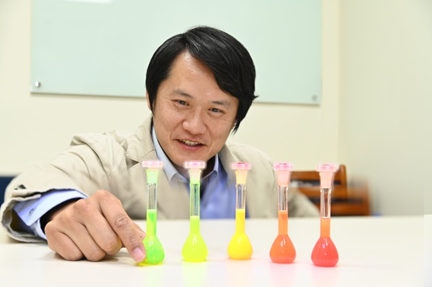NTHU Research Team Develops Next Generation of Display Material
2020.01.10
A research team led by Prof. Sean Chen of the Department of Materials Science and Engineering has recently announced that they have developed a new quantum dot material which is more stable and provides more realistic color. The main limitations of the current generation of quantum dot display material is that they are unstable and easily damaged, and the team has rectified this by putting a 1-nanometer “shield” on each quantum dot. The new material has a wide range of applications, including the screens used in televisions, computers, mobile phones, and cameras.
With the support of the university, the team has already applied for a patent for the new material and has established the Xinhua Optical Energy Company to produce it on a commercial scale. It is expected that the first new quantum dot screens will begin production in this year.
Most of the displays currently on the market are liquid crystal displays (LCD), which have a color gradation and saturation limiting display to only one third of the colors visible to the human eye, and even the so-called “retinal grade” OLED displays used in such devices as the iPhone 11 can only display about half of the colors visible to the human eye. According to Chen, displays produced with this new material (QLED) will display nearly 90% of the colors visible to the human eye.
However, there are still a few challenges to be overcome before quantum dot material goes into widespread use. Chen explained that quantum dots are spherical crystals of about three nanometers in size, and are easily damaged by water vapor and oxidation, which diminishes their luminosity. At present, major manufacturers such as Samsung control such problem by sandwiching the quantum dots in a layer of protective film, but even the slightest gap in this layer can causes it to fail.
Inspired by the shield used by the comic book superhero Captain America in the Avengers series, Chen hit upon the idea of giving each quantum dot its own shield about one nanometer in size, which effectively resists water and oxidation, and increases stability and the display’s lifespan.
In the past two years several companies have begun selling televisions with quantum screens, but due to the fragile nature of quantum materials, they are difficult to mass produce, and the price is relatively high: a TV with a 60-inch quantum screen sells for up to NT$160,000. However, using Chen’s unique shield technology to protect the quantum dots will significantly reduce production costs.
“Once you’ve seen a quantum dot TV, you’ll never go back to an LCD TV,” said Chen with a smile. In Chen’s estimation, quantum dot displays will soon become the new standard for televisions, computer monitors, wearable devices, and mobile phones.

Prof. Sean Chen who invented a ”shield” to stabilize the quantum dot and enhance its capacity.
visited:
